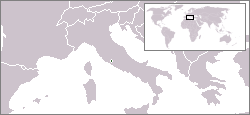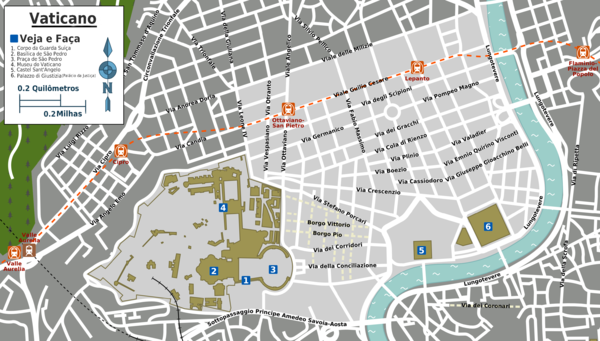| Localization | |
 | |
| Flag | |
 | |
| Basic information | |
| capital | Vatican CITY |
| Government | absolute monarchy |
| Currency | euro (EUR) |
| Area | 0.44 km2 |
| Population | 932 (est. July 2006) |
| Language | Italian and latin |
| Religion | roman catholic |
| Electricity | 230V/50Hz |
| phone code | 39 |
| Internet TLD | .go |
| Time zone | UTC 1 |
Vatican (Sancta Sedes Civitas Vaticana) is a state of Mediterranean Europe. The Vatican is the world headquarters of the Catholic Church and the Pope, it is the smallest state in the world.
Understand
History
The Papal States, which over the years have varied considerably in extent, can be traced back to 756 AD with the "Gift of Pepino". Yet the popes had been the de facto rulers of Rome and the surrounding province since the fall of the Roman Empire and the withdrawal of Byzantine power in Italy. Popes in their secular role ruled parts of the Italian peninsula for over a thousand years, until the mid-19th century, when many of the Papal States were seized by the newly United Kingdom of Italy. In 1870, the pope's holdings were still circumscribed when Rome itself was annexed.
Disputes between a series of "prisoner" popes and Italy were settled in 1929 by three Lateran Treaties, which established the independent state of Vatican City and granted special Roman Catholic status in Italy. On February 11, 1929, three treaties were signed with Italy, which, among other things, recognized the Vatican's full sovereignty and established its territorial extension.
To arrive
The Vatican is a tiny independent state embedded inside the city of Pomegranate, at Italy. When entering the obelisk square, the first striking image is the Basilica of St. Peter in the background, practically embraced by the monumental architectural works around it, decorated by dozens of columns, with huge statues at the top. Before visiting the interior of the Basilica, you can visit countless stores, located in the basements of the galleries, where the most diverse objects connected to the Vatican are for sale.
Circular

There are a total of 88 pilasters, 284 columns and 140 statues of saints measuring 3.40 meters in height each.
Look

THE St. Peter's Basilica, really impressive for its dimensions and frescoes, paintings, sculptures, stained glass windows, scattered on the floor, ceiling and walls. Many popes and other personalities are buried in the Basilica, and its tombs are monumental. Also worth mentioning is the gigantic baroque canopy, all in bronze, built by Bernini on the main altar, the St. Peter's Chair, the Gothic bronze statue of Saint Peter, created by Arnolfo di Cambio, whose right foot is worn out by the touch of tourists and pilgrims, and the famous pieta, by Michelangelo. Attached to the sacristy is the St. Peter's Treasure Museum, with a large collection of works of art, offerings by devotees and precious liturgical apparatus from various periods. Your Crypt also worth a visit, containing the tombs of various popes.

After a tour of the interior of the Basilica, there's nothing better than getting to know the Sistine Chapel, where other works and frescoes by the great master Michelangelo can be appreciated in their real dimensions. The Raphael's Rooms, with large frescoes by the Renaissance master.
Next, the request is to enjoy more works of art in the Vatican Museums and, if you have some time, so will your libraries. In a single day it is difficult to see everything in detail, and prepare to face hordes of tourists circulating through the interior, leaving some rooms virtually impassable, and above all waiting to enter, in a monstrous line that stretches for several blocks. Hours and hours can be wasted in this queue alone. The best solution is to buy your ticket in advance online. But the effort and patience are worth it. There are several museums of various specialties, all with extensive and very rich collections of international reputation. The most known are:
- Pio-Clementine Museum, with Greco-Roman pieces and some modern ones, among them celebrated works of art such as the Apollo Belvedere, attributed to Leocarés, a copy of the Apoxiomes of Lysippus, the Laocoon group and their children, O Belvedere torso and a copy of the Aphrodite of Cnidus, by Praxiteles.
- Chiaramonti Museum, with a similar collection, plus a large collection of headstones. Among its main attractions are the famous statue Augusto de Prima Porta, a copy of the Doriphorus of Polycletus and the allegorical group representing the Nile River.
- Gregorian Etruscan Museum, with a large collection of Etruscan and Italian works.
- Vatican Art Gallery, with an important collection of paintings ranging from Gothic to the 19th century.
Knife
The two main entrances to Vatican City for tourists are:
- Vatican Museums, accessible from Viale Vaticano, on the north side of the city-state and
- St. Peter's Basilica, on the southeast side of the city and accessible from Via della Conciliazione.
St Peter's Basilica is normally open 7-7. The Vatican Museums is open to the public from 9am-4pm; Monday - Saturday. Visitors can stay inside until six o'clock. The Vatican Museums are closed on Sundays, except for the last Sunday of each month, when they are open from 9-12:30. Visitors can stay inside until two o'clock. Take note that this day is normally very busy, so it is preferable to visit another day if you are able to afford it.
While guides do their best to provide assistance in seeing the collections within the Vatican, a guided tour is a much better way to make sure you get the most out of your visit.
Tours
Guided tours are provided by the Vatican itself for the approximate cost of 30.00 euros. These can be ordered in advance by fax from one month to one week before the requested tour date, or online from two months before the requested tour date. The Vatican is notorious for not responding via fax, and repeat requests are often necessary. Full details on booking such tours are available. here.
Speak
There is a great diversity of languages spoken, but the predominant language is the Italian, although the official language is Latin. Other European languages are also spoken and the English.
Buy
The Vatican has a unique economic system, a non-commercial economy that is financially supported by contributions (known as St. Peter's Obol) from Catholics around the world. He also sells postage stamps, tourist souvenirs and publications. Fees for museum access also go to church coffers.
Vatican euro coins are the rarest in circulation among European countries, so don't waste them! They are worth much more than their face value.
The Vatican is the only country in the world where ATM instructions are available in Latin.
With the
The Vatican Museum has a restaurant, a bar, a cafeteria and a pizzeria, all of which work normally during museum hours.
- LtRooms, Vatican B&B Via Moricca, 5, tel. (39) 338 4280189, [1].
- , Via Tunisia 1/B (on the corner of Via Sebastiano Veniero, 62), ☎ 39 06 90270954.
- (Located in front of Vatican City). very cheap.
- , Via E. Faa di Bruno 26 (Metro line A, Cipro.), ☎06 373 584 00. reasonable. Fish plate from around €15.
drink and go out
As a State that functions as the physical headquarters of a religious denomination, there are no bars or nightclubs in the entire territory, except those connected to the Vatican Museums where a bar can be found. However, it is easy to find places to have fun in the nearby town of Pomegranate.
sleep
- , Via Sivori 14 (few meters from the Vatican Museum), ☎ 39 3894330366, email: [email protected]. From €25.
- , Via Emo, 97, ☎ 39 339 2768290, email: [email protected]. From €70 per room.
- , Via Moricca, 5 (A few steps from metro line A), ☎ 39 338 4280189, email: [email protected]. From €50 per room.
- , Via Boezio, 31, ☎ 39 06 6874030, fax: 39 06 6867947.
- , Via Ottaviano 73, ☎ 39 06 39751474, email: [email protected]. from 30 euro
- , Viale Vaticano, 97 00193 Rome, ☎(0039) 0639030378, email: [email protected].
- , Via della Stazione di San Pietro 14, ☎ 39 06 398739, fax: 39 06 632359, email: [email protected].
- , Via della Conciliazione n° 51, ☎ 39 06 68 40 39-0, fax: 39 06 68 193 333. The Palace was built in 1400 and was purchased by Cardinal Pierdonato Cesi, who had restructured and remodeled itself, turning it into a museum of antiquities and art, and installing a well-endowed library. Today, the General of Salvatorians has converted part of the building into an elegant and exclusive "welcoming house", with 30 rooms fully equipped with all amenities.
Learn
You can learn more about the religion, architecture, history of the place and works and you can learn more when you visit the museum.
respect
It is necessary to respect the historic buildings of the Vatican that are part of the culture of this State. Never enter a building in short shirts or shorts.
Stay in touch
- Send a letter - Vatican City is an independent country, it also has its own postal system, which is generally considered to be a little more reliable than Italy. Send a postcard to your friends will be stamped from Vatican City.
| This article is a guide . It has lots of good quality information about the country, including links to destinations, attractions and arrival and departure information. Plunge forward and help it grow ! |

